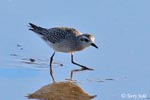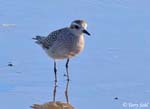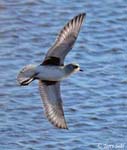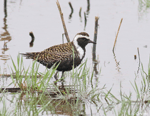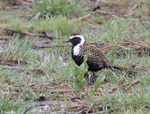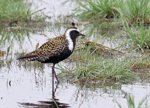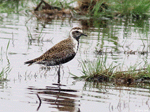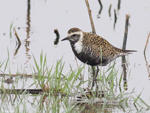| Length: 10 - 11 inches | Wingspan: 18 - 22 inches | Seasonality: Migrant |
| ID Keys: In summer, dark below, dark face, white stripe over eye extending down the neck, dark upperparts with dappled golden spots | ||
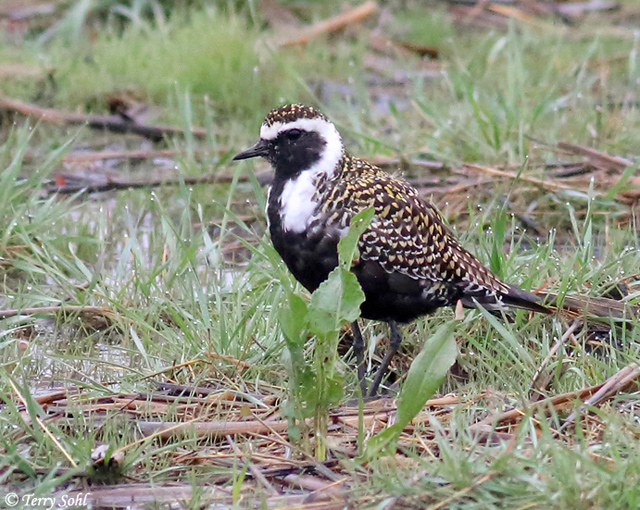 The
American Golden Plover is one of the longest-distance migrants, summering on
the Arctic Tundra, and wintering in southern South America. They are most
commonly found in South Dakota during the spring migration, as most fall birds
fly directly from
eastern Canada to South America. However, small numbers are sometimes found
during the fall migration in the state.
The
American Golden Plover is one of the longest-distance migrants, summering on
the Arctic Tundra, and wintering in southern South America. They are most
commonly found in South Dakota during the spring migration, as most fall birds
fly directly from
eastern Canada to South America. However, small numbers are sometimes found
during the fall migration in the state.
While large flocks can sometimes be seen during the spring migration, American Golden Plover were once much more common than it is presently. Hunting pressure in the 19th century and habitat loss since then have presented challenges for the species. Recent trends have again started to show a decline in overall numbers, although there are no serious conservation concerns yet.
Habitat:
During migration through South Dakota, generally found on plowed fields and prairies with short or grazed grass. They are only occasionally found on mudflats and marshy areas. Breeds on the Arctic Tundra in summer.
Diet:
Primarily feeds on insects. Will also feed on seeds, small crustaceans, small mollusks, and occasionally berries.
Behavior:
Often found foraging on the ground in plowed fields and other agricultural land, as well as heavily grazed areas.
Nesting:
The nest of an American Golden Plover is a shallow scrape on the ground in the tundra, lined with mosses and other bits of vegetation. Three or four eggs are laid, tightly placed in a circle in the nest to aid retention of warmth. Males incubate the eggs during the day, while females incubate them at night. The young hatch after about 4 weeks.
Interactive eBird Map:
Click to access an interactive eBird map of American Golden Plover sightings
Song: The primary call is a loud, rich whistling quee-dol.
1Click here to hear the alarm calls of an American Golden Plover
2Click here to hear another calling American Golden Plover
3Click here to hear the interaction calls of three American Golden Plover on their breeding grounds
Migration:
A long-distance migrant, summering in the Arctic Tundra, and wintering in South America. American Golden Plovers could be seen in either spring or fall migration in South Dakota, but they are generally more common in the spring.
Similar Species:
American Golden Plovers are potentially confused with other plover species, including at least one that may also be found as a migrant in South Dakota.
- Black-bellied Plover - Both American Golden Plovers and Black-bellied Plovers may be found as migrants in South Dakota, although Black-bellied Plovers are less common. They are similar structurally and in size, and both have black underparts, a black face and throat, and heavily spotted upperparts. However a Black-bellied Plover lacks the golden color on the back of a (breeding plumaged) American Golden Plover. Black-bellied Plovers also have white undertail coverts, compared to black undertail coverts on an American Golden Plover. In breeding plumage, the white pattern on the head and upper body is also different, with more extensive white on the head of a Black-bellied Plover.
- Pacific Golden-Plover - Pacific Golden Plovers are the most difficult species to differentiate from American Golden Plovers, but they are not found in South Dakota. Where the two species do overlap, both species (in breeding pliumage) have black, white, and gold spotting on the back. The white on a Pacific Golden Plover's head, however, extends downward along the side of the body below the wing, while it stops at the top of the wing on an American Golden Plover. The undertail coverts of a Pacific Golden Plvoer is more spotted and multicolor with black and lighter colors, while those on an American Golden Plover are completely black.
South Dakota "Hotspot"
Numbers migrating through South Dakota seem to vary substantially from year to year. There's no reliable location to always find them, but they often are found in wet or flooded farm fields during the spring migration. They can also be found near shallow water with nearby mudflats.
Conservation Status:
Populations were decimated due to 19th-century hunting pressures. Numbers have never recovered to historical levels, and diminishing habitat in their South American wintering grounds is possibly causing further declines, as systematic surveys record a declining trend in recent years. Despite the declines, populations still are relatively strong, they are found across a broad geographic area, and they are relatively common in parts of their range. The IUCN considers the American Golden Plover to be a species of "Least Concern".
Further Information:
1) BirdWeb - American Golden Plover
2) Audubon - American Golden Plover
3) WhatBird - American Golden Plover
Photo Information:
Photo taken on May 12th, 2018 - Lincoln County, South Dakota - Terry Sohl
Audio File Credits:
1Patrik Aberg. Recorded near Nome, Alaska on June 6th, 2017. Original recording and information available from xeno-canto.
2Frank Lambert. Recorded in Valdez-Cordova County, Alaska on June 8th, 2015. Original recording and information available from xeno-canto.
2Andrew Spencer. Recorded near Nome, Alaska on May 25th, 2013. Original recording and information available from xeno-canto.
| Click on the map below for a higher-resolution view |
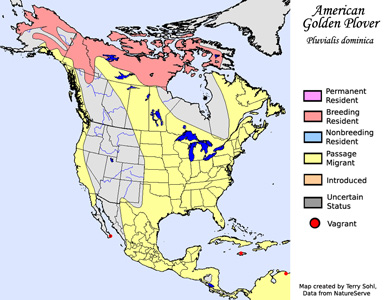 |
| South Dakota Status: Common spring and uncommon fall migrant in the eastern half of the state, rare to accidental migrant in the western half |
